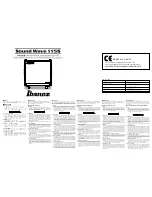
166
Appendices
Troubleshooting
Case
Cause/Remedy
The power doesn’t
come on.
Is the power cord connected and plugged in
correctly? (p. 18)
The button doesn’t
work.
Is the panel locked? (p. 157)
Turn the power off, then back on.
Nothing appears
on screen.
The KR-7/5 uses a liquid-crystal screen, so
text may not be displayed when the ambient
temperature is below freezing.
Vertical lines ap-
pear in the screen/
Color is “washed
out” at the edges of
the screen
These occur due to the nature of a liquid crys-
tal display, and do not indicate a malfunction.
They can be minimized by adjusting the
brightness of the screen. (p. 22)
The touch screen
doesn’t respond
correctly.
The positioning of the touch screen may be-
come displaced if some time has passed since
it was last used. Take a look at “Calibrating
the Touch Screen (Touch Screen)” (p. 156) to
correct the positioning.
The pedal rattles
Adjust the adjuster underneath the pedal so
that the pedal presses firmly against the floor
surface. (p. 20)
Depressing a ped-
al has no effect, or
the pedal effect
doesn’t stop.
Is the pedal connected correctly?
Make sure the pedal cord extending from the
stand is securely connected to the pedal
connector on the rear of the unit (p. 18).
Has a different function been assigned to the
pedal?
See “Assigning Functions to Pedals and Per-
formance Pads (Pedal Setting/User Func-
tions)” (p. 147).
Normal pedal operation is automatically en-
abled when the One Touch Program [Piano]
button is pressed (p. 20).
The volume level
of the instrument
connected to Input
jacks is too low.
Could you be using a connection cable that
contains a resistor?
Use a connection cable that does not contain a
resistor.
Images not shown
on external display
when external dis-
play is connected
Is the external display properly connected (p. 21)?
Is the external display’s power turned on?
Are you using a display that is compatible
with the KR?
Refer to “Displays That Can Be Connected to
This Instrument” (p. 21).
Are the KR’s settings correct?
Follow the instructions in “Selecting Images
To Be Shown on the KR-7 and External Dis-
plays (User Image Display) (KR-7)” (p. 154) to
set the “External Display” image. Also refer to
“Changing the Settings for Showing Images
with the External Display (External Display)
(KR-7)” (p. 153).
No sound is heard
No sound is heard.
Is the volume level of the KR-7/5 (p. 20) or
connected device turned all the way down?
Are headphones plugged in? (p. 20)
Has the Balance knob been moved all the way
to the right or left?
Has the volume been set to “0” using the Part
Balance? (p. 67)
Are all sliders in the Equalizer screen at the
minimum level? (p. 34)
Has the footage been adjusted so that all fre-
quency components aren’t sounded? (p. 15 in
the Quick Start)
No sound is heard
(when a MIDI in-
strument is con-
nected).
Have all devices been switched on?
Are the MIDI cables connected correctly? (p.
159)
Does the MIDI channel match the connected
instrument? (p. 160)
Is the Computer switch on the bottom of the
KR-7/5 set to “MIDI”? (p. 163)
You cannot use a
connected MIDI
device and com-
puter simulta-
neously
The MIDI connectors and the computer con-
nector cannot be used at the same time.
Confirm that the computer switch is set to
“MIDI” when a MIDI device is connected to
the MIDI connector, and to either “MAC,”
“PC-1,” “PC-2,” when a computer is connect-
ed to the Computer connector (p. 163).
No sound is heard
when the keyboard
is played.
Has Local Control been set to “Off”?
When Local Control is set to Off, no sound is
produced by playing the keyboard.
Set Local Control to On. (p. 160)
Not all played
notes are sound-
ed.
The maximum number of notes that the KR-7
can play simultaneously is 128, and that the
KR-5 can play is 64. Frequent use of the damp-
er pedal during automatic accompaniment or
when playing along with a song on floppy
disk may result in performance data with too
many notes, causing some notes to drop out.
The sound is strange
Sounds are heard
twice (doubled)
when the keyboard
is played.
Is the KR-7/5 in layer play? (p. 28)
When the KR-7/5 is connected to an external
sequencer, set it to the Local OFF mode
(p. 160). Alternatively, the sequencer could be
set so its Soft Thru feature is OFF.
Case
Cause/Remedy
Appendices
If you think there’s a problem, read this first.
KR-7_5_e.book 166 ページ 2004年7月7日 水曜日 午前10時3分
















































